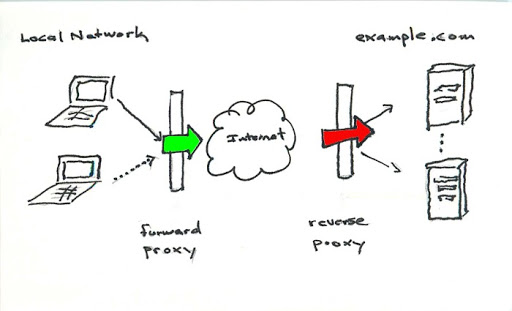
What is a reverse proxy anyway?
- 3 minsIntroduction
Even after some years dedicating myself to software engineering, and having a relatively good understanding of big applications component architectures, there was a specific resource that I could not get my head around. At least until recent months.
I am referring to what gets called “Reverse Proxy”.
In this post I will get into the details of what it is, where its name comes from, and the common misunderstanding around this specific resource.
A nomenclature nightmare
In order to clearly understand what people refer to when they talk about “Reverse Proxy”, it is better to start by looking at the big picture when considering a big software application, and its relationship with the network (or how Moss refers to it at “IT Crowd”: “The Internet”).
The architecture would contain (from left to right):
- A set of clients (web, mobile apps…).
- An optional “Proxy” that some clients may decide to use.
- “The Internet” (usually represented by a cloud).
- Some sort of “Load Balancer” to distribute requests.
- A set of server replicas.
Ok, I will stop right here.
You may be thinking: Ok, so, you are trying to explain what a “Reverse proxy” is, and this article has only named “Proxies” and “Load Balancers”. Where are the “Reverse proxies”?
The “Reverse Proxy” architecture location, and the reason why it has that name, are hidden in the previous list of network-related components, even though they are not obvious at first sight. This is why the section is called nomenclature nightmare. 🤦🏻♂️
Reverse Proxy: what is it
A “Reverse Proxy” is defined as:
“A Type of proxy server that retrieves resources on behalf of a client from one or more servers, implementing several functionalities such as: caching, contents compression, distribution of requests, and / or security procedures”.
Following the definition, “Reverse Proxy” is what lays between “The Internet” and the set of servers replicas. However, the component placed in that spot during the components listing was previous referred to as “Load Balancer”. Well, a “Load Balancer” is nothing more than a sub-type of “Reverse Proxy”, that only implements one of its functionalities: redistribution of request among several server replicas.
Therefore, we can conclude that a Reverse Proxy is a generic figure, referring to a network component placed between “The Internet” and the set of servers, implementing some of its original functionalities.
Reverse Proxy: the misunderstandings
The ‘reverse’ word
A common misunderstanding surrounding the term comes from the usage of the “reverse” word in its name. This word is very confusing as it is not clear what “reverse” refers to, in order to be considered that way.
The word “reverse” refers to the fact that these components are placed in the opposite / reverse position, with respect to “The Internet”, than the regular “Proxy”. That is not that obvious at plain sight, but it may become a bit more clear just by changing the very generic “Proxy” name, by “Forward Proxy”. Now we are talking.
The hidden presence
Another root of confusion is the fact that, even if the “Reverse Proxy” figure is usually present in big scale application diagrams, it is hard to find references to it in some orchestrator systems used nowadays.
Just consider Kubernetes, and its services documentation. Kubernetes gives developers a very easy way of deploying “Load Balancers”, as it is one of the native subtypes of “services” that it provides. However, the term “Reverse Proxy” is only mentioned one time in the whole documentation, making hard to realize that some services available to deploy, are just sub-types of a bigger general figure called “Reverse Proxy”.
Conclusion
Given the previous explanations, the original list of network-related components in a big application diagram can be decoded into the following:
- A set of clients (web, mobile apps…).
- An optional “Forward Proxy” that some clients may decide to use.
- “The Internet” (usually represented by a cloud icon).
- A “Reverse Proxy” (probably a Load Balancer) to distribute requests.
- A set of server replicas.
